Related Research Articles
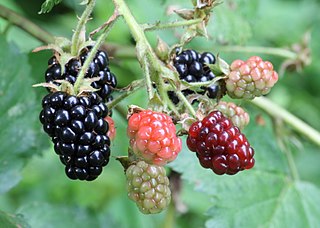
The blackberry is an edible fruit produced by many species in the genus Rubus in the family Rosaceae, hybrids among these species within the subgenus Rubus, and hybrids between the subgenera Rubus and Idaeobatus. The taxonomy of blackberries has historically been confused because of hybridization and apomixis, so that species have often been grouped together and called species aggregates. For example, the entire subgenus Rubus has been called the Rubus fruticosus aggregate, although the species R. fruticosus is considered a synonym of R. plicatus.

Plant pathology or phytopathology is the scientific study of plant diseases caused by pathogens and environmental conditions. Plant pathology involves the study of pathogen identification, disease etiology, disease cycles, economic impact, plant disease epidemiology, plant disease resistance, how plant diseases affect humans and animals, pathosystem genetics, and management of plant diseases.
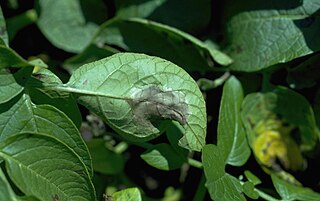
Phytophthora infestans is an oomycete or water mold, a fungus-like microorganism that causes the serious potato and tomato disease known as late blight or potato blight. Early blight, caused by Alternaria solani, is also often called "potato blight". Late blight was a major culprit in the 1840s European, the 1845–1852 Irish, and the 1846 Highland potato famines. The organism can also infect some other members of the Solanaceae. The pathogen is favored by moist, cool environments: sporulation is optimal at 12–18 °C (54–64 °F) in water-saturated or nearly saturated environments, and zoospore production is favored at temperatures below 15 °C (59 °F). Lesion growth rates are typically optimal at a slightly warmer temperature range of 20 to 24 °C.

The raspberry is the edible fruit of a multitude of plant species in the genus Rubus of the rose family, most of which are in the subgenus Idaeobatus. The name also applies to these plants themselves. Raspberries are perennial with woody stems.

Rubus spectabilis, the salmonberry, is a species of bramble in the rose family Rosaceae, native to the west coast of North America from west-central Alaska to California, inland as far as Idaho. Like many other species in the genus Rubus, the salmonberry plant bears edible fruit, typically yellow-orange or red in color, resembling raspberries in appearance.
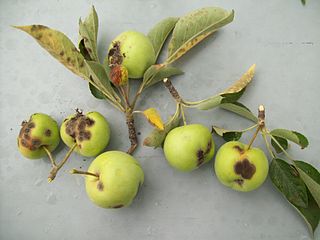
Apple scab is a common disease of plants in the rose family (Rosaceae) that is caused by the ascomycete fungus Venturia inaequalis. While this disease affects several plant genera, including Sorbus, Cotoneaster, and Pyrus, it is most commonly associated with the infection of Malus trees, including species of flowering crabapple, as well as cultivated apple. The first symptoms of this disease are found in the foliage, blossoms, and developing fruits of affected trees, which develop dark, irregularly-shaped lesions upon infection. Although apple scab rarely kills its host, infection typically leads to fruit deformation and premature leaf and fruit drop, which enhance the susceptibility of the host plant to abiotic stress and secondary infection. The reduction of fruit quality and yield may result in crop losses of up to 70%, posing a significant threat to the profitability of apple producers. To reduce scab-related yield losses, growers often combine preventive practices, including sanitation and resistance breeding, with reactive measures, such as targeted fungicide or biocontrol treatments, to prevent the incidence and spread of apple scab in their crops.

Wheat leaf rust is a fungal disease that affects wheat, barley, rye stems, leaves and grains. In temperate zones it is destructive on winter wheat because the pathogen overwinters. Infections can lead up to 20% yield loss. The pathogen is a Puccinia rust fungus. It is the most prevalent of all the wheat rust diseases, occurring in most wheat-growing regions. It causes serious epidemics in North America, Mexico and South America and is a devastating seasonal disease in India. P. triticina is heteroecious, requiring two distinct hosts.

Phytophthora palmivora is an oomycete that causes bud-rot of palms, fruit-rot or kole-roga of coconut and areca nut. These are among the most serious diseases caused by fungi and moulds in South India. It occurs almost every year in Malnad, Mysore, North & South Kanara, Malabar and other areas. Similar diseases of palms are also known to occur in Sri Lanka, Mauritius, and Sumatra. The causative organism was first identified as P. palmivora by Edwin John Butler in 1917.

Ug99 is a lineage of wheat stem rust, which is present in wheat fields in several countries in Africa and the Middle East and is predicted to spread rapidly through these regions and possibly further afield, potentially causing a wheat production disaster that would affect food security worldwide. In 2005 the noted green revolution pioneer Norman Borlaug brought great attention to the problem, and most subsequent efforts can be traced to his advocacy. It can cause up to 100% crop losses and is virulent against many resistance genes which have previously protected wheat against stem rust.

Tilletia caries is a basidiomycete that causes common bunt of wheat. The common names of this disease are stinking bunt of wheat and stinking smut of wheat. This pathogen infects wheat, rye, and various other grasses. T. caries is economically and agriculturally important because it reduces both the wheat yield and grain quality.

The American Phytopathological Society (APS) is an international scientific organization devoted to the study of plant diseases (phytopathology). APS promotes the advancement of modern concepts in the science of plant pathology and in plant health management in agricultural, urban and forest settings.

Fusarium oxysporum f. sp. cubense is a fungal plant pathogen that causes Panama disease of banana, also known as Fusarium wilt. The fungi and the related disease are responsible for widespread pressure on banana growing regions, destroying the economic viability of several commercially important banana varieties.
Ruth Florence Allen (1879–1963) was an American botanist and plant pathologist and the first woman to earn her Ph.D. in botany from the University of Wisconsin. Her doctorate research focused on the reproduction and cell biology of ferns, particularly the phenomenon of apogamy. Later in her career, Allen shifted her focus to plant pathology. Her major contribution to the field of mycology was furthering the understanding of rust fungi, a group of economically important plant pathogens. Allen completed many studies on Puccinia graminis, once considered a catastrophically damaging disease-causing agent in cereal crops before the discovery of current management measures.
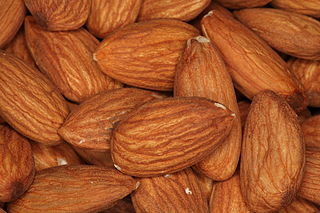
Agriculture is a significant sector in California's economy, producing nearly US$50 billion in revenue in 2018. There are more than 400 commodity crops grown across California, including a significant portion of all fruits, vegetables, and nuts in the United States. In 2017, there were 77,100 unique farms and ranches in the state, operating across 25.3 million acres of land. The average farm size was 328 acres (133 ha), significantly less than the average farm size in the U.S. of 444 acres (180 ha).
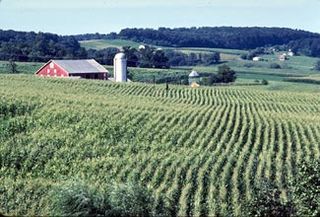
The US state of Maryland has large areas of fertile agricultural land in its coastal and Piedmont zones, though this land use is being encroached upon by urbanization. Agriculture is oriented to dairy farming for nearby large city milksheads, plus specialty perishable horticulture crops, such as cucumbers, watermelons, sweet corn, tomatoes, melons, squash, and peas.
Harold Corby Kistler is an American Adjunct Professor of biology and plant pathology at the University of Minnesota and a fellow of the American Phytopathological Society and the American Association for the Advancement of Science.

Pyraclostrobin is a quinone outside inhibitor (QoI)-type fungicide used in agriculture. Among the QoIs, it lies within the strobilurin chemical class.
Robert Harry Stover was a Canadian-Honduran phytopathologist specializing in Musa crops and their fungal diseases.

Strawberries in the United States are almost entirely grown in California – 86% of fresh and 98% of frozen in 2017 – with Florida a distant second. Of that 30.0% was from Monterey, 28.6% from Ventura, 20.0% from Santa Barbara, 10.0% from San Luis Obispo, and 9.2% from Santa Cruz. The Watsonville/Salinas strawberry zone in Santa Cruz/Monterey, and the Oxnard zone in Ventura, contribute heavily to those concentrations.
References
- ↑ "Bramble Disease - Black Raspberry Streak". Penn State Extension. Penn State College of Agricultural Sciences . Retrieved 2021-04-10.
- ↑ Converse, R. H. (1982). "Witches' Broom Disease of Black Raspberry in Oregon". Plant Disease . 66 (1). American Phytopathological Society: 949. doi:10.1094/pd-66-949. ISSN 0191-2917.
- ↑ Jarausch, W.; Jarausch-Wehrheim, B.; Danet, J.L.; Broquaire, J.M.; Dosba, F.; Saillard, C.; Garnier, M. (2001). "Detection and Indentification[sic] of European Stone Fruit Yellows and Other Phytoplasmas in Wild Plants in the Surroundings of Apricot Chlorotic Leaf Roll-affected Orchards in Southern France". European Journal of Plant Pathology . 107 (2). European Foundation for Plant Pathology (Springer): 209–217. doi:10.1023/a:1011234921833. ISSN 0929-1873. S2CID 21399530.
- ↑ Vindimian, M.E.; Grassi, A.; Ciccotti, A.; Pollini, C.P.; Terlizzi, F. (2004). "Epidemiological studies on Rubus stunt (RS) in blackberry orchards located near Trento (Italy)". Acta Horticulturae (656). International Society for Horticultural Science (ISHS): 177–180. doi:10.17660/actahortic.2004.656.28. ISSN 0567-7572. S2CID 132030063.